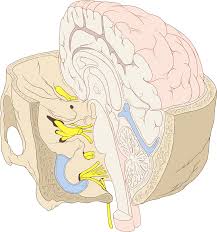Neuropathology is called the study of disease of nervous system tissue.The brain is exquisitely dependent on its oxygen supply. There is no reserve of oxygen in cerebral tissue to sustain cerebral metabolism during periods of reduced or absent cerebral blood flow. When the brain is acutely and completely deprived of oxygen generally or locally, the electroencephalogram changes within 10 to 20 seconds, and irreversible and extensive neural damage occurs in the cerebral hemispheres after 3 to 10 minutes. When ischemia is prolonged, the ischemic tissue softens, and the usually distinct margins between gray and white matter become unclear and occasionally hemorrhagic. Under the microscope, neurons are seen to be necrotic and shrunken, i.e., infarcted.
Cerebral infarctions following ischemia may be “pale” (nonhemorrhagic) or hemorrhagic. The extravasation of blood into tissues more commonly follows an embolic arterial obstruction, and pale infarcts more frequently follow atherosclerotic or thrombotic arterial obstruction. Often the two varieties of infarction blend together, and there is little advantage in extensively weighing the difference of causation.
What Does Neuropathology Diseases DO
A variable amount of cerebral edema accompanies cerebral infarction. With large infarctions the edema may be so extensive that portions of the swollen hemisphere shift under the falx or down through the tentorium cerebelli. This change in intracranial space relationships further impairs the flow of blood and cerebrospinal fluid, thus increasing the ischemia and neurologic deficit. This is often followed by secondary congestion and ischemia of the upper brainstem, which is almost invariably fatal.
It is common to find numerous old, small cerebral infarctions in patients dying from other causes, indicating that cerebral infarctions need not always give rise to symptoms. Old infarctions that have been hemorrhagic are identified at postmortem examination by the presence of hemosiderin in the wall of the infarct. As the infarct ages, the necrotic area breaks down, is absorbed, and eventually may be replaced by a fluid-filled cavity lined with glial and fibrovascular tissue.
